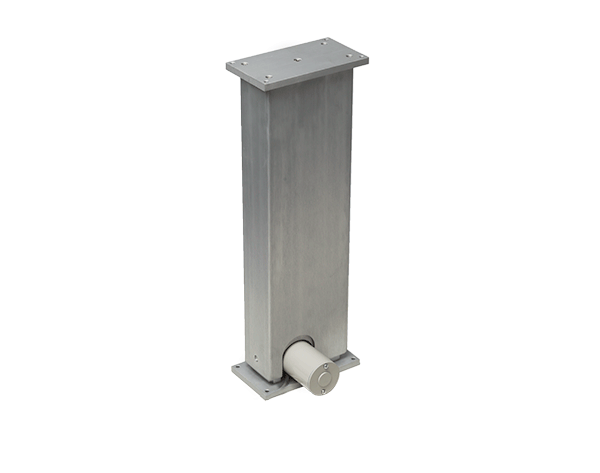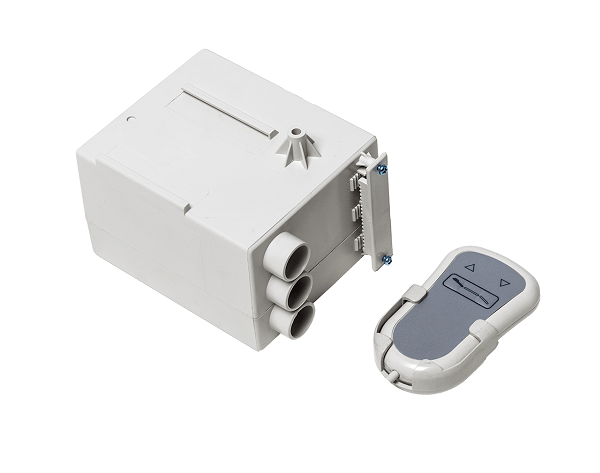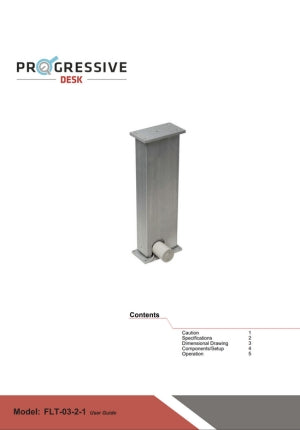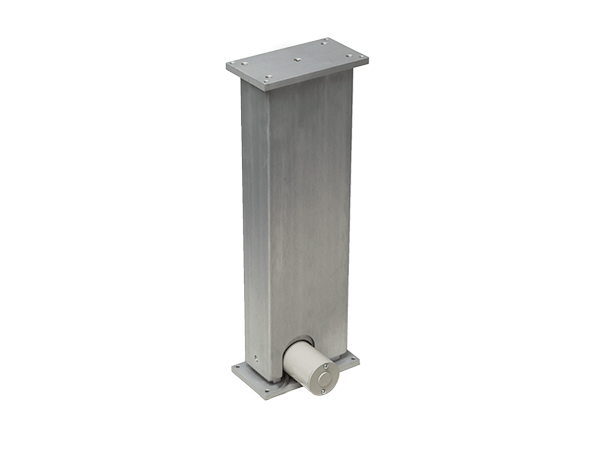
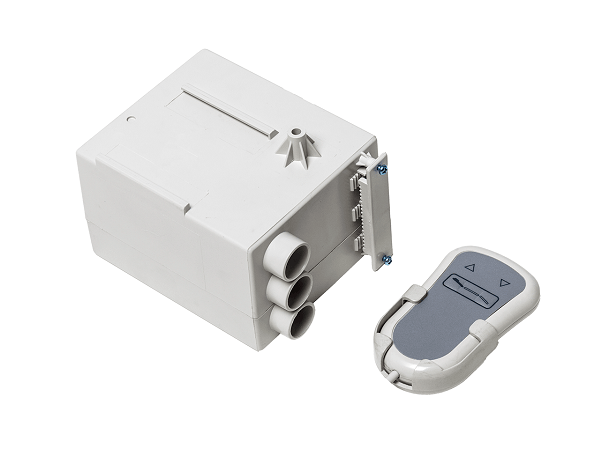
Das Hubsäulen-Set FLT-03-2-1 ist ein einspaltiges Hebesystem. Es wird mit einer Hubsäule, einem Netzteil und einer kabelgebundenen Fernbedienung für eine einfache Auf-/Ab-Steuerung geliefert. Diese Säule kann bis zu 440 lbs Kraft erzeugen und ist damit eine hervorragende Option für Schwerlast-Arbeitsplätze.
Die Installation ist mit Hilfe unseres PDF-Handbuchs ein einfacher Vorgang, das Sie hier finden. Es enthält wichtige technische Informationen wie das Reset-Verfahren, die Bedienung sowie einen Aufbauplan.
Das Hubsäulen-Set FLT-03-2-1 ist ein einspaltiges Hebesystem. Es wird mit einer Hubsäule, einem Netzteil und einer kabelgebundenen Fernbedienung für eine einfache Auf-/Ab-Steuerung geliefert. Diese Säule kann bis zu 440 lbs Kraft erzeugen und ist damit eine hervorragende Option für Schwerlast-Arbeitsplätze.
Die Installation ist mit Hilfe unseres PDF-Handbuchs ein einfacher Vorgang, das Sie hier finden. Es enthält wichtige technische Informationen wie das Reset-Verfahren, die Bedienung sowie einen Aufbauplan.
Die Einhaltung von Normen ist für Unternehmen unerlässlich, um sicherzustellen, dass ihre Produkte und Dienstleistungen ein Qualitätsniveau erreichen, das die Kundenzufriedenheit fördert. Wir bei Progressive Automations streben stets nach dem Besten für unsere Kunden und verbessern uns kontinuierlich. Daher freuen wir uns, Ihnen mitteilen zu können, dass Progressive Automations nun nach ISO 9001:2015 zertifiziert ist!
Qualität, der Sie vertrauen können – Erfahren Sie mehrWir können nicht garantieren, dass unsere Fernbedienungen mit Steuerungssystemen von Drittanbietern kompatibel sind. Die Pinbelegung der Anschlüsse kann je nach Hersteller variieren.
Yes, the L shaped standing desk is orientation-friendly and can be installed by your preference. Here is a step-by-step article that explains how this is possible: FLT-05 User Manual
NOTE: The steps below may vary depending on the remote model that you have. The following instructions were made for the standard RT-11 remote. To set the maximum height for your frame, go to the desired height you would like to set and follow the steps below:
- Press M and see [5 -] indicated on the display
- Press the UP button and notice [5 -] blinks
- Hold the M button until you see [999] on the display
- The maximum height has now been set
To set the minimum height for your frame, go to the desired height you would like to set and follow the steps below:
- Press M and see [5 -] indicated on the display
- Press the DOWN button and notice [5 -] blinks
- Hold the M button until you see [000] on the display
- The minimum height has now been set
To reset the limits, follow the steps below:
- Press M and see [5 -] indicated on the display and release
- Hold the M you see [555]
- Limits have been reset
NOTE: The steps below may vary depending on the remote model you have. The following instructions were made for the standard RT-11 remote.
If you have to hold down the remote’s buttons to get to your pre-set height, this means that your control box is in momentary control. To set your remote to non-momentary mode, follow the steps below
- Make sure that there is nothing underneath your desk, as we have to enter the reset procedure
- Press and hold the DOWN button until the display shows [ASr]
- Once [ASr] is shown, press and hold down [1] and you may see two values:a. 10.1 = Non-momentary Mode b. 10.2 = Momentary Mode
- Complete the reset procedure by holding the DOWN button until your standing desk slightly lowers and rises.
Our standing desks have 3 settings for collision detection, and this can be set depending on your preference. To proceed, follow the steps below:
- Make sure that there is nothing underneath your desk as we have to enter the reset procedure
- Press and hold the DOWN button until the display shows [ASr]
- Once [ASr] is shown, press and hold the UP [ ^ ] button and you may see three values:a. 10.5 = 11 lbsb. 10.6 = 22 lbsc. 10.7 = 33 lbs
- Complete the reset procedure by holding the DOWN button until your standing desk slightly lowers and rises.
We have some troubleshooting steps for you to take if you see any of the following error codes on the frames with FLTCON series control boxes:
Сheck the error code here.
If the issue you are experiencing persists after following these steps, please feel free to contact our technical product engineers at 1-800-676-6123, or send us an email at sales@progressiveautomations.com.
Depending on your application, there are different specification requirements you should consider when determining the linear actuator you need. These requirements include force, stroke, speed and mounting dimensions. For detailed actuator information, you can refer to either the datasheet or the specification table located on the selected actuator's product page. You can also contact us to speak with one of our expert engineers.
TastverhältnisDer Tastgrad gibt den Anteil der Arbeitszeit an, in dem ein Linearantrieb aktiv bleiben kann. Sie können den Tastgrad eines Linearantriebs mithilfe der folgenden Gleichung berechnen:Arbeitszyklus (%) = (Zeit, in der der Linearantrieb aktiv ist) / (Zeit für eine Arbeitsperiode)
Beispiel: Bei einem Arbeitszyklus von 25 % kann ein Aktor 5 Minuten lang ununterbrochen laufen, bevor er 15 Minuten ruhen muss, bevor er wieder in Betrieb genommen werden kann.
SchlaganfallDer Hubweg der Ausfahrstange wird mit bezeichnet. Um die benötigte Hublänge zu ermitteln, messen Sie den Abstand zwischen der vollständig eingefahrenen und der vollständig ausgefahrenen Position. Die Differenz entspricht der benötigten Hublänge.
Wir empfehlen stets, einen Aktor mit einer höheren Nennkraft als für die jeweilige Anwendung erforderlich zu kaufen. Falls Sie sich bezüglich Ihrer Kraftanforderungen unsicher sind, kann Ihnen dieser Artikel bei der Berechnung helfen:Wie man die Kraft berechnet, um den richtigen Linearantrieb zu finden
Ja, das ist möglich. Es hängt jedoch von den verwendeten Geräten ab. Zur Synchronisierung von Aktuatoren ist eine Rückkopplung erforderlich, beispielsweise über ein Potentiometer oder Hall-Sensoren. Weitere Informationen finden Sie in unseren wichtigsten Artikeln zur Synchronisierung von Linearantrieben weiter unten.
DerKontrollkästchenDas von Ihnen gewählte Gerät sollte die erforderliche Spannung und Stromstärke für Ihren Aktor liefern. Falls Sie sich bezüglich der Spezifikationen unsicher sind, wenden Sie sich bitte an uns.Kontaktieren Sie unsDie
Alternativ finden Sie kompatible Steuereinheiten auch auf der Produktseite des von Ihnen ausgewählten Linearantriebs.
Backdriving is when an actuator starts sliding down under load, when it is either overloaded or when the actuator has been damaged. Watch the video.
What Does Dynamic and Static Load Ratings Mean?Dynamic load rating is the amount of weight an actuator can pull or push safely when being powered. Static load rating is the amount of weight the actuator can hold or withstand without back driving when it is not being powered. For example, let's just say you have an actuator installed on a window and the static load rating of the actuator is 100lbs, it could experience backdriving when there is a high wind event, which means there will be more pressure exerted on the actuator which would exceed the 100lbs load rating of the actuator.
What Is Lateral Loading?Lateral loading is when the actuator experiences forces from the lateral plane. Actuators are not meant to handle lateral forces at all so if it experiences any lateral forces, it will likely damage the actuator or bend the rod. So it's advised never to use lateral forces and always make sure the actuator is fully in line or in sync with your application, so it does not take any load other than the axial load. Watch the video.
